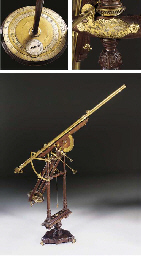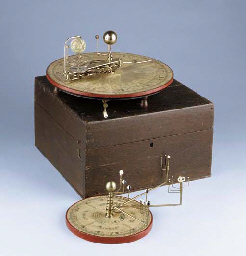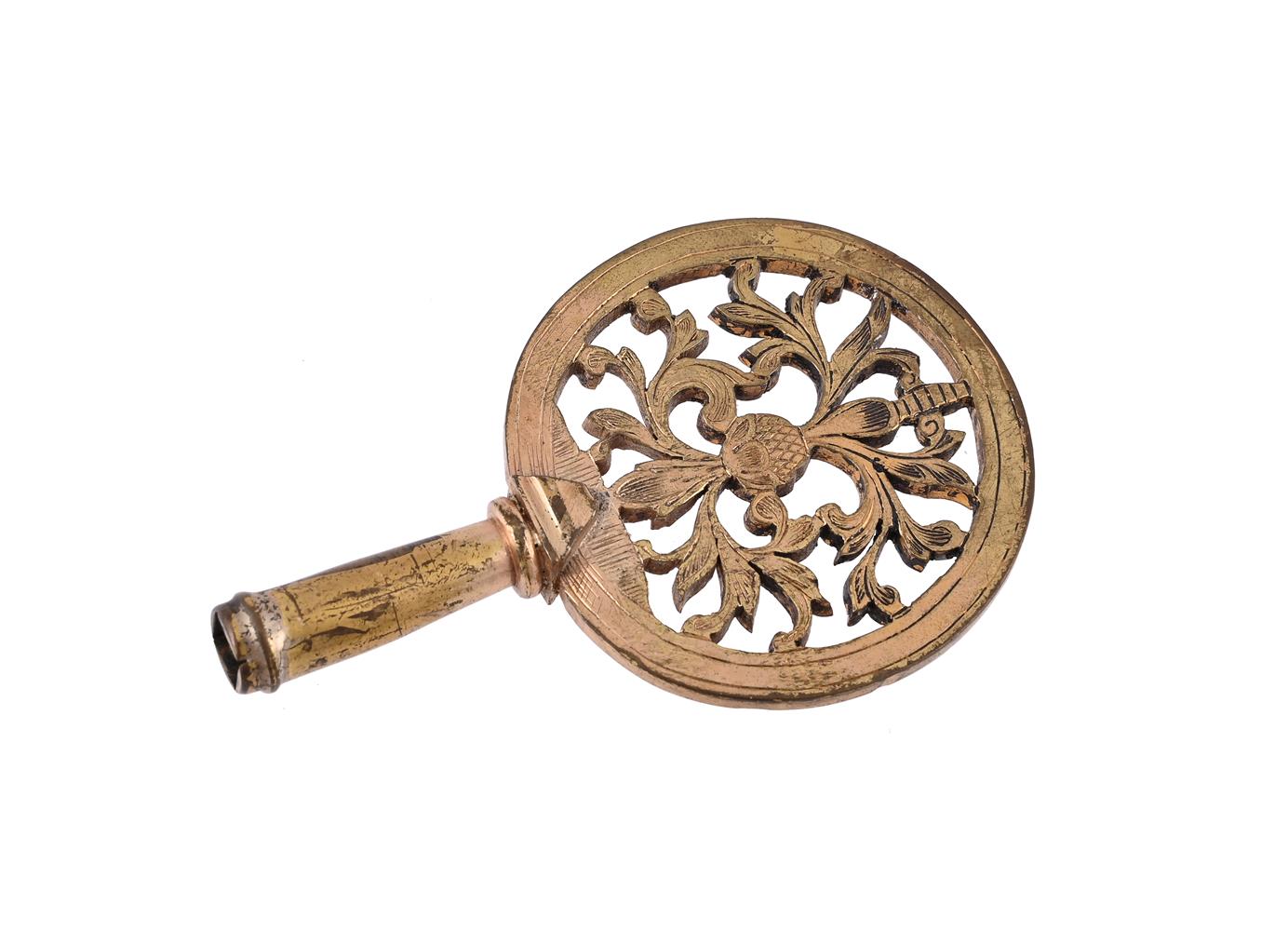A rare English brass Gunter pattern horary quadrant Unsigned, mid 17th century The heavy brass plate applied with twin pinhole sight vanes, the apex pierced with a hole for plumb line and engraved with a shadow square annotated 1-10 in both directions and divided into fifths, below is a sector arranged as a quarter of an astrolabe for a fixed latitude showing the sky projection between equator and tropics crossed by the ecliptic divided with a Zodiacal scale, horizon and azimuth lines, the outer band with double calendar scale annotated I, F, M, A, M, I in one direction and I, A, S, O, N, D in the other within degree scale annotated 0-90 to limb, radius 10.1cm (4ins). The layout of the current lot was devised by Edmund Gunter who first published the design in 1623. Gunter was born in Hertfordshire in 1581 and studied at Oxford as an undergraduate 1600-03. During this time he developed his interest in mathematics and started designing his own instruments including a sector. In 1615 Gunter took holy orders and became rector at both St. Mary Magdalen, Oxford and St, Georges, Southwark. Around this time he also spent more and more time at Gresham College working alongside his friend Henry Briggs who was professor of geometry which ultimately led to his appointment as the third Gresham professor of astronomy in 1620. In 1623 Edmund Gunter published his work De Sectore et Radio or The Description and Use of the Sector, the Cross-staffe and other instruments which included the design of quadrant on which the current lot is very closely based. The current instrument appears to be laid out for vernal equinox of 21 March, consistent with the Gregorian calendar (still in effect in England at this time) and for latitude of 52° for London. It also incorporates an edge scale of solar declination adjacent to the quadrantal scale for observing altitudes of sun and stars onto which the sky positions of at least three bright stars are also plotted. Once supplied with a plumb line incorporating a sliding bead the quadrant can be used to establish the suns position in the Zodiac at a particular time of year and for finding the azimuth of the sun at a particular time of day as well as other astronomical functions.
A rare English brass Gunter pattern horary quadrant Unsigned, mid 17th century The heavy brass plate applied with twin pinhole sight vanes, the apex pierced with a hole for plumb line and engraved with a shadow square annotated 1-10 in both directions and divided into fifths, below is a sector arranged as a quarter of an astrolabe for a fixed latitude showing the sky projection between equator and tropics crossed by the ecliptic divided with a Zodiacal scale, horizon and azimuth lines, the outer band with double calendar scale annotated I, F, M, A, M, I in one direction and I, A, S, O, N, D in the other within degree scale annotated 0-90 to limb, radius 10.1cm (4ins). The layout of the current lot was devised by Edmund Gunter who first published the design in 1623. Gunter was born in Hertfordshire in 1581 and studied at Oxford as an undergraduate 1600-03. During this time he developed his interest in mathematics and started designing his own instruments including a sector. In 1615 Gunter took holy orders and became rector at both St. Mary Magdalen, Oxford and St, Georges, Southwark. Around this time he also spent more and more time at Gresham College working alongside his friend Henry Briggs who was professor of geometry which ultimately led to his appointment as the third Gresham professor of astronomy in 1620. In 1623 Edmund Gunter published his work De Sectore et Radio or The Description and Use of the Sector, the Cross-staffe and other instruments which included the design of quadrant on which the current lot is very closely based. The current instrument appears to be laid out for vernal equinox of 21 March, consistent with the Gregorian calendar (still in effect in England at this time) and for latitude of 52° for London. It also incorporates an edge scale of solar declination adjacent to the quadrantal scale for observing altitudes of sun and stars onto which the sky positions of at least three bright stars are also plotted. Once supplied with a plumb line incorporating a sliding bead the quadrant can be used to establish the suns position in the Zodiac at a particular time of year and for finding the azimuth of the sun at a particular time of day as well as other astronomical functions.















Try LotSearch and its premium features for 7 days - without any costs!
Be notified automatically about new items in upcoming auctions.
Create an alert